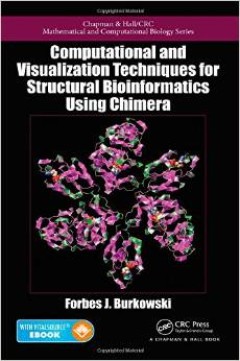Filter by

Molecular evolutionary models in drug discovery
- Edition
- -
- ISBN/ISSN
- 9780128176139
- Collation
- xii, 179 p. : ill. : ind. ; 23 cm.
- Series Title
- -
- Call Number
- 615.19 Bue m
- Edition
- -
- ISBN/ISSN
- 9780128176139
- Collation
- xii, 179 p. : ill. : ind. ; 23 cm.
- Series Title
- -
- Call Number
- 615.19 Bue m

Molecular evolution
This text describes the dynamics of evolutionary change at the molecular level, the driving forces behind the evolutionary process, and the effects of the various molecular mechanisms on the structure of genes and genomes. It also explains the methodology involved in dealing with molecular data.
- Edition
- -
- ISBN/ISSN
- 0878934634
- Collation
- xv, 487 p. : ill. : ind. ; 26 cm.
- Series Title
- -
- Call Number
- 572.838 Wen m

Molecular evolution : a phylogenetic approach
The study of evolution at the molecular level has given the subject of evolutionary biology a new significance. Phylogenetic 'trees' of gene sequences are a powerful tool for recovering evolutionary relationships among species, and can be used to answer a broad range of evolutionary and ecological questions. They are also beginning to permeate the medical sciences. In this book, the authors app…
- Edition
- -
- ISBN/ISSN
- 9780865428898
- Collation
- v, 346 p. : ill. : ind. ; 25 cm.
- Series Title
- -
- Call Number
- 572.838 Pag m

Fundamentals of molecular evolution
This book describes the dynamics of evolutionary change at the molecular level, the driving forces behind the evolutionary process, the effects of the various molecular mechanisms on the structure of genes, proteins, and genomes, the methodology involved in dealing with molecular data from an evolutionary perspective, and the logic of molecular hypothesis testing. The Second Edition incorporate…
- Edition
- 2nd
- ISBN/ISSN
- 9780878932665
- Collation
- xiv, 481 p. : ill. : ind. ; 24 cm.
- Series Title
- -
- Call Number
- 572.838 Gra f

Computational molecular evolution
Computational Molecular Evolution provides an up-to-date and comprehensive coverage of modern statistical and computational methods used in molecular evolutionary analysis, such as maximum likelihood and Bayesian statistics. Yang describes the models, methods and algorithms that are most useful for analysing the ever-increasing supply of molecular sequence data, with a view to furthering our un…
- Edition
- -
- ISBN/ISSN
- 9780198567028
- Collation
- xvi, 357 p. : ill. : ind. ; 24 cm.
- Series Title
- -
- Call Number
- 572.8 Zih c

Bioinformatics and molecular evolution
In the current era of complete genome sequencing, Bioinformatics and Molecular Evolution provides an up-to-date and comprehensive introduction to bioinformatics in the context of evolutionary biology. This accessible text: provides a thorough examination of sequence analysis, biological databases, pattern recognition, and applications to genomics, microarrays, and proteomics emphasizes the theo…
- Edition
- -
- ISBN/ISSN
- 9781405106832
- Collation
- xiii, 365 p. : ill. : ind. ; 25 cm.
- Series Title
- -
- Call Number
- 572.8 Hig b

Computational and visualization techniques for structural bioinformatics usin…
A Step-by-Step Guide to Describing Biomolecular Structure Computational and Visualization Techniques for Structural Bioinformatics Using Chimera shows how to perform computations with Python scripts in the Chimera environment. It focuses on the three core areas needed to study structural bioinformatics: biochemistry, mathematics, and computation. Understand Important Concepts of Structura…
- Edition
- -
- ISBN/ISSN
- 9781439836613
- Collation
- xxv, 419 p. : ill. : ind. ; 24 cm.
- Series Title
- -
- Call Number
- 572.330285 Bur c

Molecular evolution and phylogenetics
During the last ten years, remarkable progress has occurred in the study of molecular evolution. Among the most important factors that are responsible for this progress are the development of new statistical methods and advances in computational technology. In particular, phylogenetic analysis of DNA or protein sequences has become a powerful tool for studying molecular evolution. Along with th…
- Edition
- -
- ISBN/ISSN
- 9780195135855
- Collation
- xiv, 333 p. : ill. : ind. ; 27 cm.
- Series Title
- -
- Call Number
- 572.838 Nei m

Molecular evolution : a statistical approach
Studies of evolution at the molecular level have experienced phenomenal growth in the last few decades, due to rapid accumulation of genetic sequence data, improved computer hardware and software, and the development of sophisticated analytical methods. The flood of genomic data has generated an acute need for powerful statistical methods and efficient computational algorithms to enable their e…
- Edition
- 1st edition
- ISBN/ISSN
- 9780199602612
- Collation
- xv, 492 p. : ill. : ind. ; 26 cm
- Series Title
- -
- Call Number
- 572.838 Zih m
 Computer Science, Information & General Works
Computer Science, Information & General Works  Philosophy & Psychology
Philosophy & Psychology  Religion
Religion  Social Sciences
Social Sciences  Language
Language  Pure Science
Pure Science  Applied Sciences
Applied Sciences  Art & Recreation
Art & Recreation  Literature
Literature  History & Geography
History & Geography